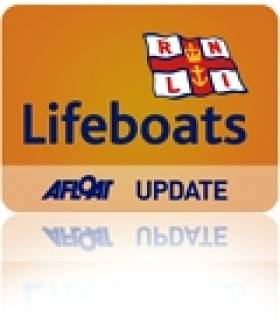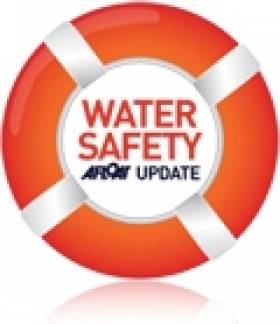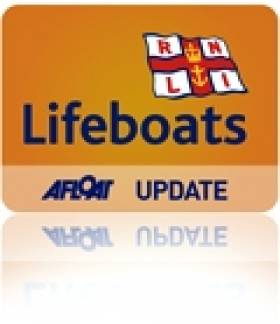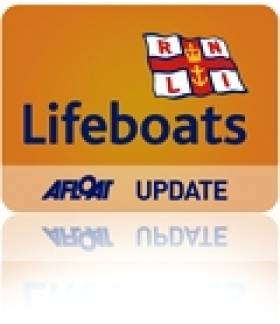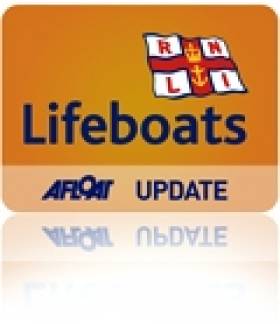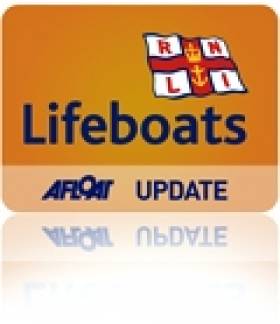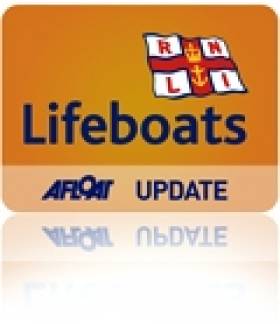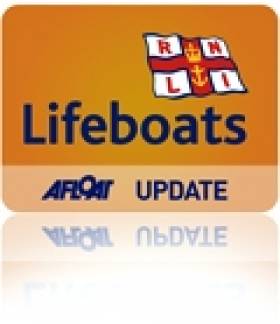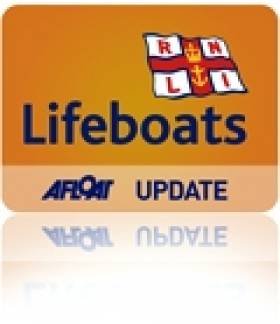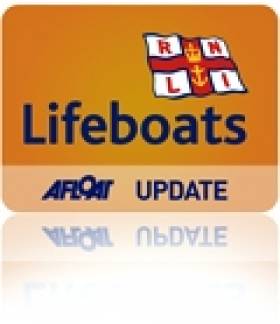Displaying items by tag: Lifeboats
Kilmore Quay Lifeboat In Christmas Day Surfer Rescue
#RNLI - Kilmore Quay RNLI volunteers had a Christmas Day call-out last week when a surfer got into difficulties just before 4pm.
The man had been surfing at the Burrow Shore off the Memorial Garden to the west of the Co Wexford lifeboat station when he drifted towards the rocky end of the beach, where it would have been dangerous for him to come ashore.
Weather conditions were good at the time, with a light north-westerly breeze with an on-shore swell, good visibility and overcast sky - so the lifeboat crew had no problems responding swiftly, taking the lifeboat’s Y-boat to recover the surfer and his board.
No medical assistance was required and the surfer and his board were landed safely back at the marina.
The Kilmore Quay surfer was just one of hundreds who took to the wintry waters around the coast as Christmas Day saw an array of special events nationwide, from surfing in Strandhill to swimming in Sandycove.
As the Irish Independent reports, locals at Banna Beach in Co Kerry were treated to the incredible sight of 300 people running into the freezing Atlantic in a charity challenge for the local sea rescue unit.
And in Dublin, the traditional Forty Foot plunge brought out its regular contingent of hardy souls.
Bundoran RNLI Urges Safety Over The Christmas Break
#Safety - Bundoran RNLI is among those urging water users to exercise common sense and safety over the current holiday period as persistent stormy weather makes sea conditions treacherous around the Irish coast.
With water hobby gifts like surfboards, bodyboards and kayaks a certainty under the tree on the 25th, the RNLI advises that all usual safety checks should be performed before heading out into the water.
If you are using equipment for the first time, make sure you know how to operate it correctly and most of all take a sensible approach when using this equipment in the water.
Check the weather forecast, check the conditions of the beach or water areas you are in and if you are unsure, seek the advice of a local surf school or coastguard who will be happy to advise you of any imminent or hidden dangers.
Bundoran RNLI lifeboat operations manager Tony McGowan adds: "We want people to enjoy the holidays and any new sporting gifts they receive for Christmas but of course we also want people to be safe and come back in one piece if they venture into the water.
"The lifeboat will as usual be on standby 24/7 over the holiday period and will be ready to launch if requested."
As the end of the year draws close, all of the crew of Bundoran RNLI wish to thank each and every supporter who has contributed to the charity this year for their generous donations.
Volunteer lifeboat press officer Shane Smyth says: "It’s been a busy year for our fundraising teams with big events like the annual Dinner Dance, the Soapbox Race, the Station to Station Challenge and of course the Boat Push.
"Thanks to all of our supporters and our fundraisers who work quietly in the background. Your help to keep us running is very much appreciated. We’d like to wish you all a very happy Christmas and a happy and safe 2014."
Tickets are now on sale for the annual dinner dance which takes place at the Great Northern Hotel on Friday 31 January 2014 with entertainment from Derek Ryan.
Holyhead Lifeboat's Decade Of Lifesaving
#RNLI - Holyhead RNLI volunteers are coming together to mark the 10th anniversary of their all-weather lifeboat that safeguards waters familiar to many an Irish ferry passenger.
To celebrate the milestone, the volunteer RNLI crew have commissioned a decorative bell paying tribute to each volunteer who has served aboard Christopher Pearce.
The bell will be unveiled to the volunteer crew who will also receive an anniversary glass this Wednesday 18 December.
Launching 205 times since entering service at Holyhead, Christopher Pearce - the only Severn class lifeboat of her kind in Wales - has rescued 307 people.
A total of those 11 people rescued owe their lives to the volunteer crew and would not be celebrating Christmas this year had Christopher Pearce not come to their rescue.
The vessel – which is named after Christopher Pearce, who bequeathed the money before his death in 1997 – has seen some unique, challenging and difficult rescues during its 10 years on station.
In 2006 the all-weather lifeboat saw some of its most unusual rescues. A swan-shaped pedalo drifting in a busy shipping lane 25 miles out to sea required their assistance during the summer.
Then two young Irish men who stole a fishing trawler to sail home across the Irish Sea after missing the last ferry required their assistance after sailing in circles around the Anglesey coast.
In 2007, the all-weather lifeboat was launched to the large vessel Smitt Cymran which had hit rocks and was sinking seven miles out of Holyhead. The five people were lifted off by RAF sea king helicopter. The volunteer lifeboat crew worked hard to keep vessel afloat.
More recently, in 2011, Christopher Pearce was launched to assist other North Wales lifeboats in searching for missing men after the cargo ship Swanland sank.
The volunteer crew had to contend with Force 9 winds into a very rough and confused sea. Two crew members were rescued alive from the ship but five other crew members were never found.
"Ten years does not seen like a long period of time," commented Holyhead RNLI lifeboat press officer Ray Steadman, "but the changes Holyhead RNLI has seen over the years have been phenomenal.
"We’ve seen the introduction of new lifejackets and training is more intense than ever before. We’ve seen people come through the door as youngsters develop into fully fledged competent crew members. Single people walked through the door who are now married, with families of their own but the commitment is still as strong as it ever was.
"Ten years on, these people still appear in freezing conditions, the cold and the rain to drop everything they are doing to help people in trouble at sea. At Christmas or any other time of the year, that’s the level of commitment required to become an RNLI volunteer and we are looking forward to celebrating that dedication."
Full-time coxswain Brian Thomson, who has led his crew through some difficult rescues, added: "Since Christopher Pearce arrived on station she has served the volunteer crew exceptionally well. We have seen some challenging and unique rescues in difficult conditions, but myself and the crew have every confidence in their lifeboat which has grown during the last decade when she has battled gales and rough seas.
"As people around the country prepare for Christmas, we have our own very special cause for celebration in Holyhead and will felt it was only right to mark the occasion with a lasting reminder of those who have served on our much-loved lifeboat Christopher Pearce.
"The specially commissioned bell is a gift from all the crew to each other which reflects how life boating is all about teamwork and having trust in one another."
A second lifeboat, financed by a legacy from Pearce's brother Andrew after his death in 1988, is stationed at Llandudno and is named Andy Pearce.
The men's mother, Diana Pearce from Cheshire, asked for the money left by her son Christopher to be specifically used for the Holyhead lifeboat, remembering the holidays the family enjoyed in North Wales when the boys were younger.
When the Herald of Free Enterprise ferry sank in the English Channel in 1987, the government and the RNLI agreed that a fast Severn class lifeboat should be at every major ferry port. Holyhead was one of the last stations in the UK to have the improved vessel stationed there - but it is the first in Wales.
Bushmills Anglers Raise Funds For Portrush Lifeboat
#RNLI - Portrush RNLI's volunteer lifeboat crew received a cheque for £1,052 (€1,249) from Bushmills District and Angling Club recently.
The club, which collects donations throughout the year or the lifesaving charity, made the presentation to Portrush lifeboat operations manager Robin Cardwell at the Co Antrim lifeboat house.
Club chair Vincent McLaughlin said: "Our members value the work of the volunteer crew members and when you are out on the sea, you never know when you are going to need the RNLI.
"It’s always a nice sight to see the lifeboat moored in the harbour ready to go when called. It’s a pleasure to hand this cheque over to the Portrush crew in appreciation of the work they do."
Cardwell added: "The crew really appreciate the donations from our local anglers and are delighted that year on year they continue to show us tremendous support."
Festive Cheer At RNLI's Dublin Reindeer Run
#RNLI - Nearly 1,000 people from all over Leinster and beyond took part in the annual RNLI Reindeer Run at Marlay Park on Sunday 1 December.
It was a sea of festive red as entrants in the 5K, 10K and Santa Saunter got into the Christmas spirit by wearing a novelty pair of antlers and a special Reindeer Run T-shirt.
Supporting the runners and walkers around the course this year were lifeboat crew from Dublin’s three stations in Howth, Skerries and Dun Laoghaire. From the latter, Damien Payne was joined by colleague Paul Cummins took an extra step by running the 5K in their full RNLI crew kit.
Also mooing the runners was 98FM’s Teena Gates, who led the warm-up sessions with Rookie the Reindeer. Gates also took part in the short Santa Saunter organised for the event’s younger participants before running in the 5K.
As for the winners? It was Longford man Stephen Farrell who was first around the 10K course while Alison Davidson from Dublin took the honours for the ladies. Nicolae Buceanu won the 5K men’s event while Emer Dillon from Arklow was the first of the women to the finish line.
Speaking after the successful day, RNLI community fundraising manager for Leinster Pauline McGann said: "We were thrilled with how the event went and that so many people turned out to support the RNLI. The atmosphere was great, with children and adults all getting into the Christmas spirit and enjoying the different events.
"It was a great way to kick off the festive season while raising vital funds and we would like to thank everyone who took part."
The Marlay Park Reindeer Run was sponsored by Green Property, Haines Fleet and SuperValu Malahide.
Wicklow Lifeboat Aids Fishermen, Courtown Volunteers Recognised
#RNLI - Wicklow RNLI's all-weather lifeboat launched shortly after 12.20pm on Friday 29 November to go to the assistance of a stranded fishing vessel.
The lifeboat crew located a vessel drifting nine miles south east of Wicklow Head after 1pm. The fishing boat, with four crew, had suffered engine failure and was unable to return to port.
The volunteer crew quickly established a towline and the fishing vessel was taken back to Wicklow harbour. It was brought alongside the East pier just before 3pm.
The crew on the callout were coxswain Nick Keogh, mechanic Brendan Copeland, Ciaran Doyle, Brendan Kavanagh, Carol Flahive, Dean Mulvihill and Graham Fitzgerald.
In other lifeboats news, a presentation was made to recently honour many years of service from five Courtown RNLI lifeboat crew members.
Volunteer lifeboat crew members Orla Woods, Nuala Sinnott, Brian Bergin and Paul Woods were all recognised for their many years of dedicated service to the RNLI at an event in Courtown's Taravie Hotel.
Crewmember Fintan O'Donoghue was also presented with a statuette to mark his many years of selfless volunteering.
O'Donoghue is still a very active member of Courtown lifeboat and is now a deputy launch officer and station mechanic.
All Courtown lifeboat crew members are volunteers and give their time freely to save lives at seas.
Two Cancer Survivors Who Sailed Round Ireland Raise €8,255 for the RNLI
Two incredible Limerick men who have both battled cancer have presented the RNLI and two cancer charities with a cheque for €8,255 each after they successfully sailed round Ireland. The two friends Chris Egan and Dave Bevan from Foynes Yacht Club in Limerick decided to take on the daunting challenge when Chris, who had battled cancer, approached his friend Dave, who had huge maritime experience, with the idea of doing a 'Round Ireland Sail'. The attempt became all the more poignant when Dave himself developed cancer a short time later.
The men were joined on the voyage by a former Kilmore Quay RNLI lifeboat crewmember, Gerry Hutton and members of Foynes Yacht club. Between them they successfully completed the challenge, arriving home two months after they set off on the May Bank Holiday weekend. The men and their supporters were raising funds for three charities close to their heart; the RNLI, the Mid-Western Cancer Foundation and the Irish Cancer Society.
The group only took only two short breaks during the attempt. The first was after they reached the Aran Islands off Galway and hit a patch of bad weather; the RNLI lifeboat crew based on Inis Mhór kept an eye on their boat while they went home to wait out the weather before returning to resume their journey. The second was in Cahersiveen, County Kerry to attend family events.
According to the men one of the bonuses of the trip was that it brought them to many of the locations around the coast where the RNLI has lifeboat stations. Dave Bevan also managed to receive his final chemotherapy treatment while on the trip, pulling into Cork and visiting the hospital.
Commenting on their incredible voyage Chris Egan said, "I am delighted we were successful in our round Ireland sail and that we managed to raise nearly €25,000 for three important charities. I class myself as a Mickey Mouse Sunday Sailor and it is a world away from my day job as a postman but it has been one of the greatest experiences of my life. The warm welcome we received around the coast, especially when we reached RNLI lifeboat stations, was tremendous.
I also can't thank enough all the generous people who sponsored us and raised funds, from a bag pack to a raffle, people really dug deep for charity. I've already put the RNLI on notice that we'd love to do it again, but this time going anti-clockwise. You never know.'
Receiving the cheque on behalf of the RNLI at Foynes Yacht club was Beverley Callendar, a volunteer souvenir secretary with the charity. Beverley had kept in touch with the sailors and helped where she could with introductions to RNLI volunteers on the coast. Beverley added, 'I have huge admiration for Chris and Dave. The fact that after battling serious illness they would then turn their thoughts to raising money for charity is incredible. The funds they raised will help Irish volunteer lifeboat crewmembers in their work saving lives at sea both in training and through their equipment. On behalf of the RNLI I would like to personally thank Chris and Dave for their generosity.'
Anyone interested in learning more about the trip can look at photographs from Chris and Dave's adventures on their Facebook page: Sail Against Cancer Ireland.
Search Resumes For Lobsterman Missing Off Wexford Coast
#RNLI - The search for a lobster fisherman missing off the Wexford coast was set to resume this morning after it was suspended at sunset last night.
RNLI lifeboats from Kilmore Quay, Rosslare and Fethard launched yesterday afternoon (Monday 25 November) to search for the fisherman after his boat was found empty at Shoal Rock, at the bottom of Great Saltee Island off Wexford.
The alarm was raised at 12.50pm after another fisherman in the area noticed that the boat had been stationary in the water for some time.
Kilmore Quay RNLI co-ordinated the sea search, and along with lifeboats from Rosslare and Fethard they were joined by up to 25 local boats in the search for the missing man.
The search was also joined by the Irish Coast Guard helicopter and divers from the Naval Service, who were taken to the scene onboard the Rosslare lifeboat.
Weather conditions yesterday were described as good and visibility was excellent.
'Safety Sunday' With Lifeboat Launches In Wicklow And Skerries
#RNLI - Wicklow RNLI went to the assistance of three fishermen whose 36ft fishing boat suffered engine failure near Wicklow Head yesterday afternoon (Sunday 24 November).
The alarm was raised after the crew were unable to start the engine and were concerned about the possibility of their boat being swept ashore.
The Wicklow RNLI all-weather lifeboat launched at 2.30pm under the command of coxswain Ciaran Doyle, followed a few minutes later by the inshore lifeboat.
The drifting fishing vessel was located 10 minutes later about half a mile east of Brides Head. Weather conditions at the time had the wind at a northerly Force 3, with a slight sea state and good visibility.
A towline was quickly established and the stricken vessel was towed back to Wicklow by the lifeboat before 3pm with no further incident.
Much earlier in the day, the Skerries RNLI volunteer crew were tasked to investigate reports of a person in the water in Balbriggan Harbour in the small hours of the morning.
The crew were paged at 12:30am and the lifeboat was launched shortly after with helms Joe May, Conor Walsh and David Knight and crew member Peter Kennedy on board.
There was a Force 3 to 4 northwesterly wind blowing at the time and the sea state was moderate.
The lifeboat proceeded directly to Balbriggan Harbour where it was quickly determined that the person had been taken from the water and was receiving first aid treatment by members of Dublin Fire Brigade and the HSE ambulance service.
The lifeboat then proceeded to carry out a thorough search of the harbour to ensure that there was nobody else in the water before returning to station.
Speaking afterwards, helm Joe May said: "Our volunteer crew are on call 24 hours a day, 365 days of the year. The pager can go off at any time but we are always ready to respond."
Book Charting History Of Arklow RNLI Launches This Friday
#RNLI - Olympic gold medallist and son of Arklow, Ronnie Delaney, will be on hand this Friday 22 November for the official launch of a new book that charts the history of the Wexford town's lifeboat station.
As previously reported on Afloat.ie, To the Banks & Beyond was written by local historian Jim Rees, who spent a number of years putting together the project that recounts the history of Arklow RNLI from 1826 to the present day in words and pictures.
A limited run of hardback editions has already sold out, but the paperback is still available priced at €15 (plus P&P) via Arklow RNLI Fundraising or the lifeboat station shop at 0402 32850 or [email protected].



























